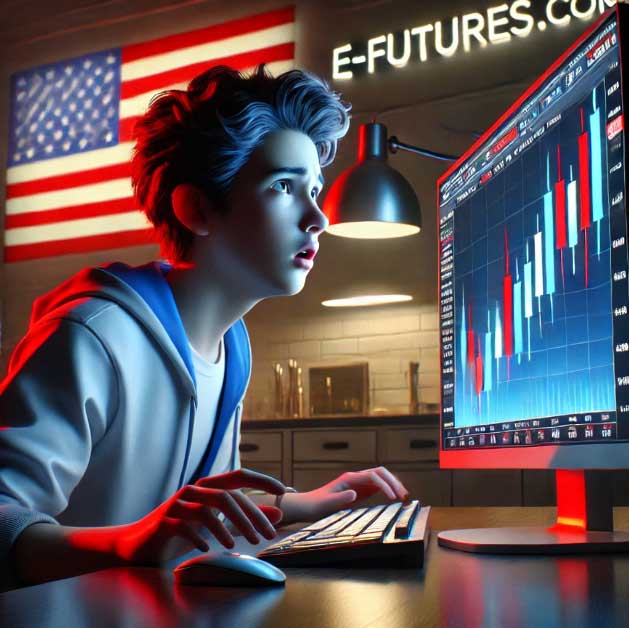E-mini futures trading offers a gateway into futures markets for traders interested in gaining exposure to large financial indices with relatively lower capital requirements. These contracts are smaller in size than standard futures contracts, and they allow traders to speculate on or hedge against movements in the underlying indexes. Common types of e-mini futures include the E-mini S&P 500, E-mini Nasdaq-100, and E-mini Russell 2000, each of which represents a “mini” version of a major stock index. This article covers essential insights for first-time traders in e-mini futures, key risks involved, psychological challenges, and the importance of emotional control. Additionally, we’ll explore why E-Futures.com is an excellent choice for new traders looking to enter the market.
The concept of e-mini futures was first introduced by the Chicago Mercantile Exchange (CME) in 1997 with the E-mini S&P 500. These contracts allowed investors to trade a scaled-down version of the S&P 500 Index futures, making it accessible to retail traders who might not have the capital required for full-sized futures. Since then, e-mini futures have expanded to cover other major indices, including the E-mini Nasdaq-100 and E-mini Russell 2000, enabling traders to access technology and small-cap markets. Because of their smaller size, e-mini futures have lower margin requirements and offer liquidity, making them highly attractive for beginners and experienced traders alike.
Key Insights for First-Time Traders
For first-time traders stepping into e-mini futures trading, here are some essential insights:
- Start Small: Initially, focus on a single e-mini contract type, like the E-mini S&P 500 or E-mini Nasdaq, to develop your skills without overextending your capital.
- Understand the Product: Learn the mechanics of the specific e-mini futures you are trading. Each product, such as the E-mini Nasdaq or E-mini Russell 2000, has its unique characteristics, including volatility, tick size, and liquidity.
- Develop a Trading Plan: Create a solid trading plan that defines your risk tolerance, entry and exit strategies, and profit goals. A well-defined plan keeps emotions in check and helps you avoid impulsive decisions.
- Set Realistic Expectations: E-mini futures offer opportunities, but they also carry significant risks. Realize that consistent profits will take time and that you may experience losses early on.
- Practice with Simulated Trading: Platforms like E-Futures.com often offer demo accounts where you can practice e-mini futures trading without real financial exposure. This practice helps develop familiarity with market movements, platform features, and order placement.
Risks in E-mini Futures Trading
While e-mini futures present opportunities, they also come with various risks that traders must carefully consider:
- Leverage Risk: Futures contracts are leveraged instruments, meaning traders can control large amounts of an asset with a small initial margin. Leverage can amplify both gains and losses, leading to potential margin calls if a trade moves unfavorably.
- Market Volatility: E-mini futures are subject to market volatility, which can lead to rapid price fluctuations. The E-mini Nasdaq, for instance, is highly susceptible to changes in technology stocks, which can experience sharp price swings.
- Liquidity Risk: While e-mini futures typically have high liquidity, during certain times (e.g., market close, economic announcements), liquidity may decrease, leading to slippage or challenges in executing trades at the desired price.
- Counterparty Risk: Although regulated exchanges mitigate counterparty risk, there is still a possibility of trading disruptions due to technology issues, clearing defaults, or unprecedented market events.
- Psychological Risk: Trading e-mini futures can be emotionally taxing. Traders may face stress, impulsive decision-making, and anxiety, which could affect their trading performance.
Psychological Risks and Pitfalls
Psychology plays a central role in trading success. Some of the primary psychological risks and pitfalls that e-mini futures traders encounter include:
- Fear and Greed: These two emotions are prevalent in trading. Fear may lead to hesitation in executing a well-planned trade, while greed can drive a trader to overextend their position in hopes of higher profits. Both emotions can lead to suboptimal decision-making.
- Overtrading: New traders, in particular, may feel compelled to trade constantly, assuming that increased activity leads to greater profit potential. However, overtrading can lead to excessive fees and higher risk exposure without a corresponding increase in profit.
- Revenge Trading: After a loss, traders may feel the urge to “win back” their money by taking more significant risks or entering trades without proper analysis. Revenge trading can lead to a cycle of losses, as emotional trades tend to be poorly planned.
- Confirmation Bias: Traders often seek information that confirms their existing beliefs, ignoring contrary data. In e-mini futures trading, this bias can lead to sticking with a bad trade or overlooking critical market information.
- Loss Aversion: Studies show that people fear losses more than they appreciate gains. In futures trading, this can lead to holding onto losing positions too long, hoping for a turnaround instead of cutting losses.
Disciplines to Apply in Futures Trading
The skills and disciplines that lead to success in e-mini futures trading often overlap with those that are beneficial in other areas of life. Here are some valuable disciplines to apply in trading:
- Patience and Consistency: Like any other skill, mastering e-mini futures trading takes time and consistent practice. This discipline allows traders to make progress without being discouraged by early losses or setbacks.
- Risk Management: Managing risk is a discipline that applies to many fields. Traders should avoid excessive risk-taking and aim to protect their capital. Using stop-loss orders, setting predefined risk limits, and adhering to a sound trading plan are crucial for success.
- Adaptability: Markets are dynamic, and conditions can change rapidly. Successful traders must be adaptable, willing to adjust their strategies based on new information or changing market conditions.
- Discipline in Execution: Discipline is critical in futures trading, where adherence to a trading plan is essential. This discipline involves resisting the urge to deviate from your strategy when emotions are high.
- Continuous Learning: Markets are complex, and new insights, techniques, and information become available regularly. Traders should continuously invest in their education by studying technical analysis, market trends, and trading psychology.
Importance of Emotional Control in Trading Futures
Emotional control is essential in trading, especially in leveraged markets like e-mini futures. Here’s why:
- Prevents Impulsive Decisions: Trading involves real-time decision-making, where impulses can lead to rapid losses. Emotional control helps traders avoid hasty actions that could derail their strategies.
- Enables Focus on Long-term Goals: Emotionally controlled traders are better able to stick to their trading plan and stay focused on long-term profitability rather than short-term fluctuations.
- Reduces Stress and Anxiety: High levels of stress can lead to poor decision-making. Traders with good emotional control experience less anxiety and are less likely to make reactionary trades.
- Builds Resilience: Trading success is rarely instant. Losses, setbacks, and challenges are part of the process. Emotional control helps traders recover from losses without losing confidence or abandoning their strategies.
- Promotes Rational Risk Management: Emotional control allows traders to assess risks logically. Instead of letting emotions dictate their risk tolerance, emotionally stable traders can evaluate risk from a rational perspective.
Why E-Futures.com is a Great Choice for E-mini Futures Trading
E-Futures.com has become a highly regarded platform for e-mini futures trading, offering an array of advantages for both beginners and experienced traders. Here’s what makes them an excellent choice:
- Decades of Experience: E-Futures.com has a longstanding presence in the futures industry, backed by a team of knowledgeable professionals. With extensive experience in e-mini futures trading, the platform has developed tools and resources tailored to various trader needs.
- Excellent Reputation: E-Futures.com has consistently received top ratings, including a 5 out of 5-star rating on TrustPilot, which reflects its high level of customer satisfaction. The platform’s reliability, customer service, and user-friendly interface contribute to its positive reputation.
- Regulatory Compliance: E-Futures.com is compliant with regulatory bodies, providing a safe and secure environment for e-mini futures trading. Compliance with regulations ensures that traders can focus on their strategies without worrying about platform security or integrity.
- Advanced Trading Tools: The platform offers advanced trading tools, including customizable charting software, one-click trading, and real-time data feeds, which are essential for e-mini futures traders. These tools allow traders to conduct thorough technical analysis and execute trades quickly.
- Educational Resources: E-Futures.com provides educational resources that are particularly helpful for beginners. Resources such as webinars, tutorials, and market analysis help traders improve their understanding of e-mini futures trading and enhance their skills.
- Competitive Commission Structure: E-Futures.com offers competitive commission rates, making it cost-effective for active traders. This benefit allows traders to focus on trading strategies without the burden of high transaction fees.
E-mini futures trading offers an exciting opportunity for traders to participate in large markets with relatively lower capital requirements. The E-mini S&P 500, E-mini Nasdaq, and E-mini Russell 2000 are just a few examples of the products that attract traders seeking leveraged exposure to major indices. However, new traders must consider the unique risks of e-mini futures trading, including leverage risk, market volatility, and the psychological challenges associated with trading.
Developing emotional control is crucial to success in e-mini futures trading, as it enables traders to manage stress, avoid impulsive decisions, and adhere to their trading plan. Disciplines such as patience, risk management, and adaptability are essential at any stage of a trader’s career, as they help in navigating the dynamic nature of futures markets.
Platforms like E-Futures.com provide traders with a reputable, well-equipped environment for e-mini futures trading. With decades of experience, regulatory compliance, high ratings, and a suite of advanced trading tools, E-Futures.com is an excellent choice for both new and seasoned traders. As you enter the world of e-mini futures trading, remember that success takes time, discipline, and a commitment to continuous learning.
To open an account with E-Futures.com, please click here.
Ready to start trading futures? Call US 1(800)454-9572 – Int’l (310)859-9572 email info@cannontrading.com and speak to one of our experienced, Series-3 licensed futures brokers and start your futures trading journey with E-Futures.com today.
Disclaimer – Trading Futures, Options on Futures, and retail off-exchange foreign currency transactions involves substantial risk of loss and is not suitable for all investors. Past performance is not indicative of future results. You should carefully consider whether trading is suitable for you in light of your circumstances, knowledge, and financial resources. You may lose all or more of your initial investment. Opinions, market data, and recommendations are subject to change at any time.
Important: Trading commodity futures and options involves a substantial risk of loss. The recommendations contained in this writing are of opinion only and do not guarantee any profits. This writing is for educational purposes. Past performances are not necessarily indicative of future results.
**This article has been generated with the help of AI Technology. It has been modified from the original draft for accuracy and compliance.
***@cannontrading on all socials.








